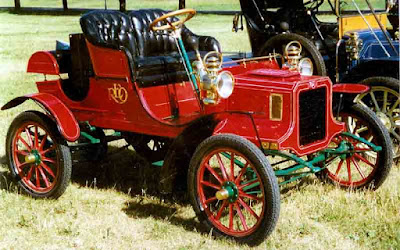"Fool Automobiling" in Pelham in 1906
In January, 1906, a reporter decided to investigate the issue of reckless driving in Pelham. On a Sunday afternoon he positioned himself on Shore Road (referencing it as "Pelham Road") near Pelham's border with New York City. From there he could see the sharp curve in Shore Road where the roadway often floods today. He watched the roadway for four hours.
During that four-hour period, 207 automobiles passed. Of the 207 cars, 31 never slowed at the sharp curve. The reporter observed five accidents on the curve during the four-hour period and noted that the automobiles were damaged in each instance, but no one was hurt. He further noted that "In a half mile stretch at this point there is no sidewalk and the street is only thirty-one feet wide, but at times motorists tried to pass each other traveling three abreast at not less than twenty miles an hour." According to the reporter, pedestrians trying to walk along the roadway were forced to beat a path into the ditch repeatedly as the automobiles came careening around the sharp curve.
During those four hours only two "teams" (i.e., horse-drawn conveyances) passed on the roadway. The reporter noted that most horse-drawn vehicles were forced to avoid Shore Road, "all having been compelled to utilize the Boston Post Road a half mile farther inland and thus lose the beautiful scenery along the Sound."
The reporter must have alerted local Pelham Manor authorities of what he had observed. He reported that "right at this point, within a month, constables and a Justice of the Peace will be stationed to arrest the road hog -- and, of course, a great howl will be set up, although every arrest probably will be deserved."
* * * * *
Below is the text of the article on which today's Historic Pelham Blog posting is based. It is followed by a citation and link to its source.
"FOOL AUTOMOBILING
-----
MANUFACTURERS, with only a few exceptions, insist that legislation regarding automobiles is an unnecessary hardship and more than that unconstitutional. There is not the slightest doubt that the same regulations that apply to horse-drawn vehicles would be sufficient protection against highway accidents if it were not that about one out of every ten motorists either is mentally incapable of sanely running a car or else criminally negligent and careless in the handling of his machine.
As an example of this statement, the writer spent an entire Sunday afternoon last month watching automobiles traveling on Pelham road between the boundary of Pelham Bay Park and Pelhamdale avenue, in Pelham Manor. Within three hundred yards of Pelhamdale avenue is a fairly sharp turn in the road, hidden on two sides by trees and an embankment. In four hours 207 cars of one kind and another passed the point. Of these 31 took the turn at the same speed they had been making straightaway, while 176 slowed down, and yet the danger to the car that slowed down was greater than it was to the speeding car.
In four hours there were five accidents on the turn, but fortunately each was to an automobile. In a half mile stretch at this point there is no sidewalk and the street is only thirty-one feet wide, but at times motorists tried to pass each other traveling three abreast at not less than twenty miles an hour.
Pedestrians have beaten a path in the ditch and in four hours only two teams were seen on that street, all having been compelled to utilize the Boston Post Road a half mile farther inland and thus lose the beautiful scenery along the Sound.
This is the sort of thing that causes legislation and local hold-ups, and right at this point, within a month, constables and a Justice of the Peace will be stationed to arrest the road hog -- and, of course, a great howl will be set up, although every arrest probably will be deserved.
Why do not some of the leading automobile clubs have committees watch a few of the dangerous road turns about the country and take the numbers of the offenders, sending the same to the clubs to which the speeders belong, asking those clubs to admonish the idiots in question and inform them that upon second offense, their names would be sent to the Secretary of State?
This sooon would put an end to Mr. Hog and help automobiling infinitely. -- The Outing Magazine for February."
Source: FOOL AUTOMOBILING, The San Francisco Call, Feb. 18, 1906, p. 26, cols. 2-3.
Archive of the Historic Pelham Web Site.
Home Page of the Historic Pelham Blog
Order a Copy of "Thomas Pell and the Legend of the Pell Treaty Oak."
Labels: 1906, Accident, Automobile, Pelham Manor, Shore Road, Transportation



0 Comments:
Post a Comment
<< Home